Analysis of Groundwater Treatment Methods in Arabian Gulf
VerifiedAdded on 2023/04/21
|18
|4513
|164
Report
AI Summary
This report provides an overview of groundwater treatment methods applicable to the Arabian Gulf region, where water resources are scarce and groundwater salinity is high. It proposes a solution involving desalination and reverse osmosis, highlighting the direct filtration process, coagulation, flocculation, and filtration techniques. The report outlines the preliminary design of a water treatment plant, including units for screening, grit removal, rapid mixing, sedimentation, and filtration. It also discusses conventional water treatment processes and their advantages and disadvantages. The document emphasizes the importance of addressing water scarcity and ensuring safe drinking water in the Arabian Gulf, recommending the implementation of appropriate water treatment technologies. Desklib offers additional resources like past papers and solved assignments for students.
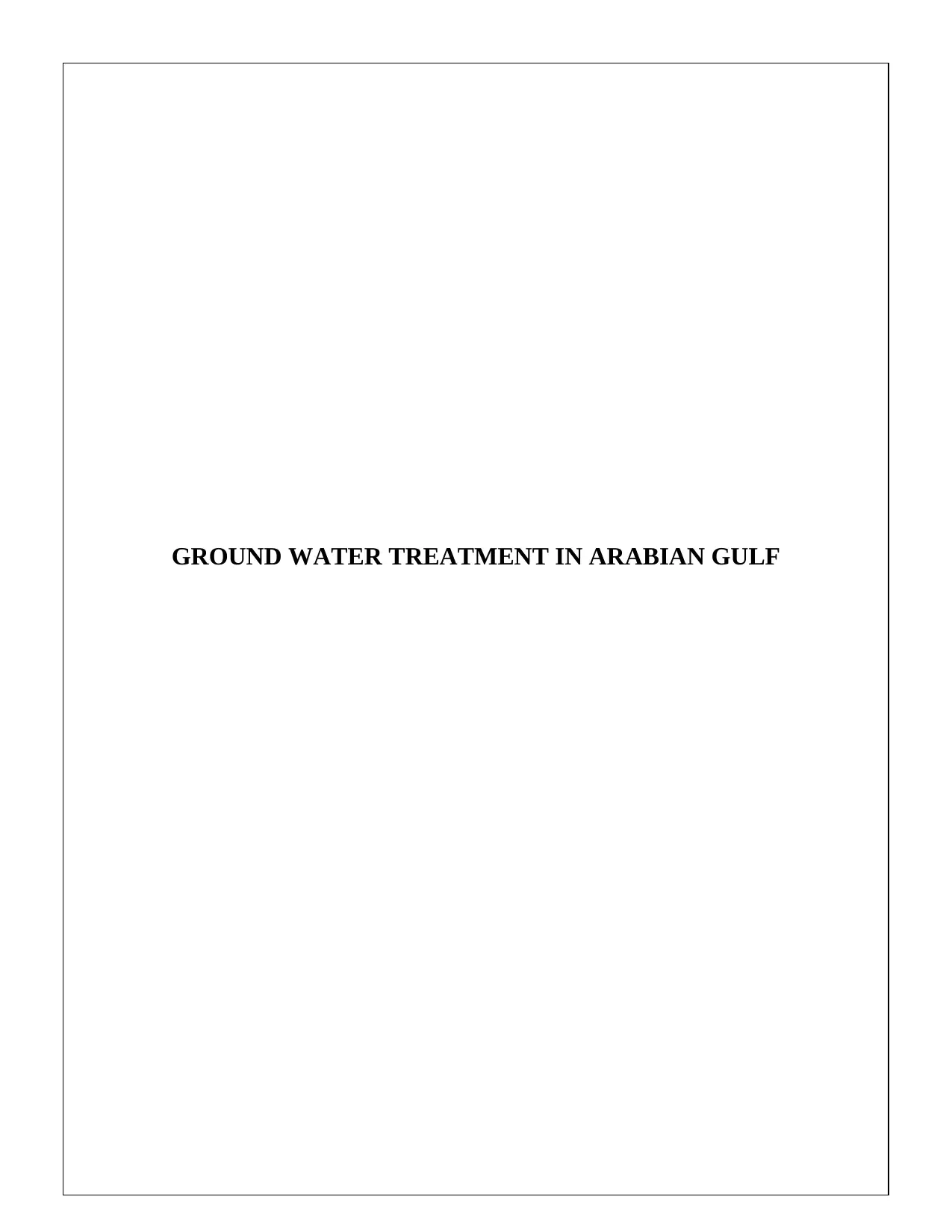
GROUND WATER TREATMENT IN ARABIAN GULF
Paraphrase This Document
Need a fresh take? Get an instant paraphrase of this document with our AI Paraphraser
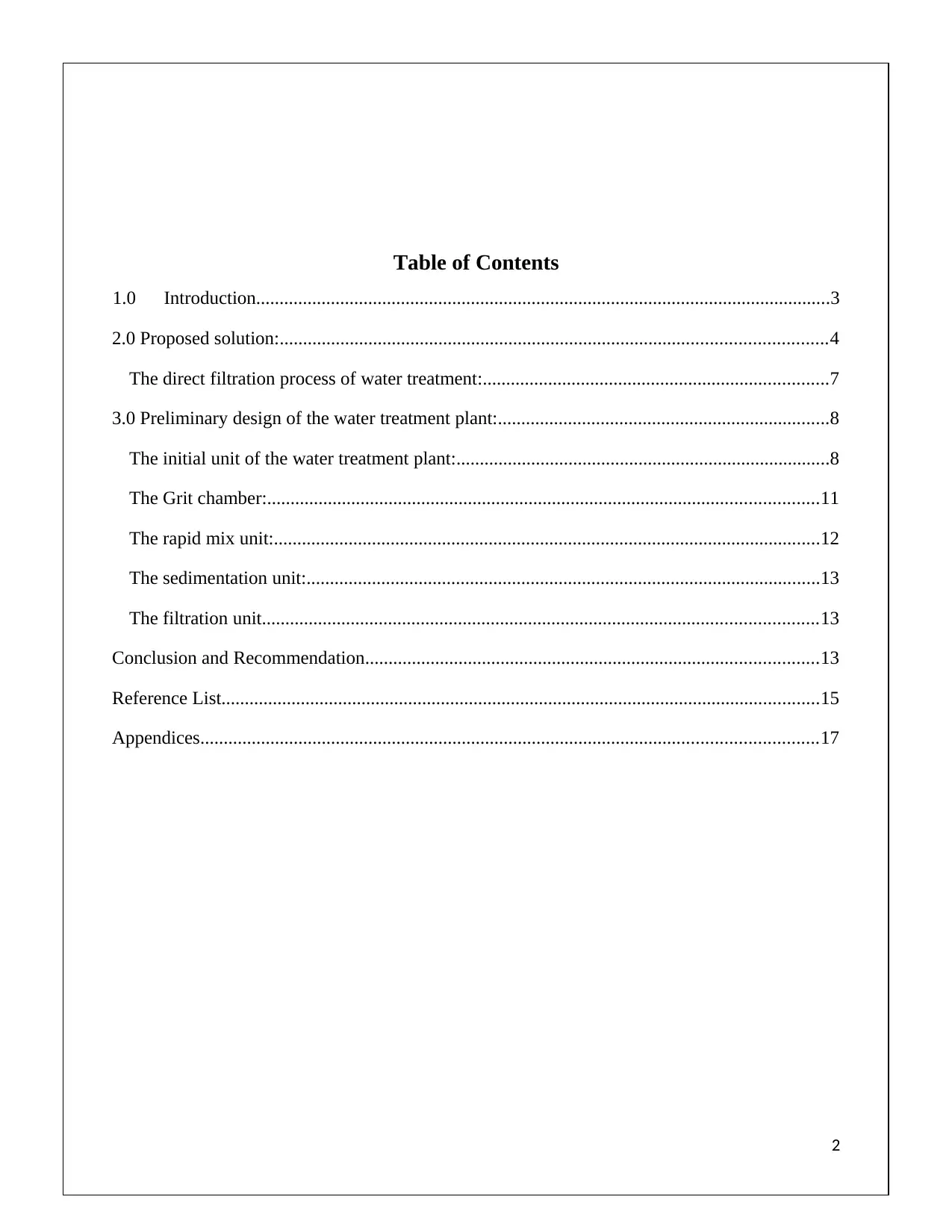
Table of Contents
1.0 Introduction...........................................................................................................................3
2.0 Proposed solution:.....................................................................................................................4
The direct filtration process of water treatment:..........................................................................7
3.0 Preliminary design of the water treatment plant:.......................................................................8
The initial unit of the water treatment plant:................................................................................8
The Grit chamber:......................................................................................................................11
The rapid mix unit:.....................................................................................................................12
The sedimentation unit:..............................................................................................................13
The filtration unit.......................................................................................................................13
Conclusion and Recommendation.................................................................................................13
Reference List................................................................................................................................15
Appendices....................................................................................................................................17
2
1.0 Introduction...........................................................................................................................3
2.0 Proposed solution:.....................................................................................................................4
The direct filtration process of water treatment:..........................................................................7
3.0 Preliminary design of the water treatment plant:.......................................................................8
The initial unit of the water treatment plant:................................................................................8
The Grit chamber:......................................................................................................................11
The rapid mix unit:.....................................................................................................................12
The sedimentation unit:..............................................................................................................13
The filtration unit.......................................................................................................................13
Conclusion and Recommendation.................................................................................................13
Reference List................................................................................................................................15
Appendices....................................................................................................................................17
2
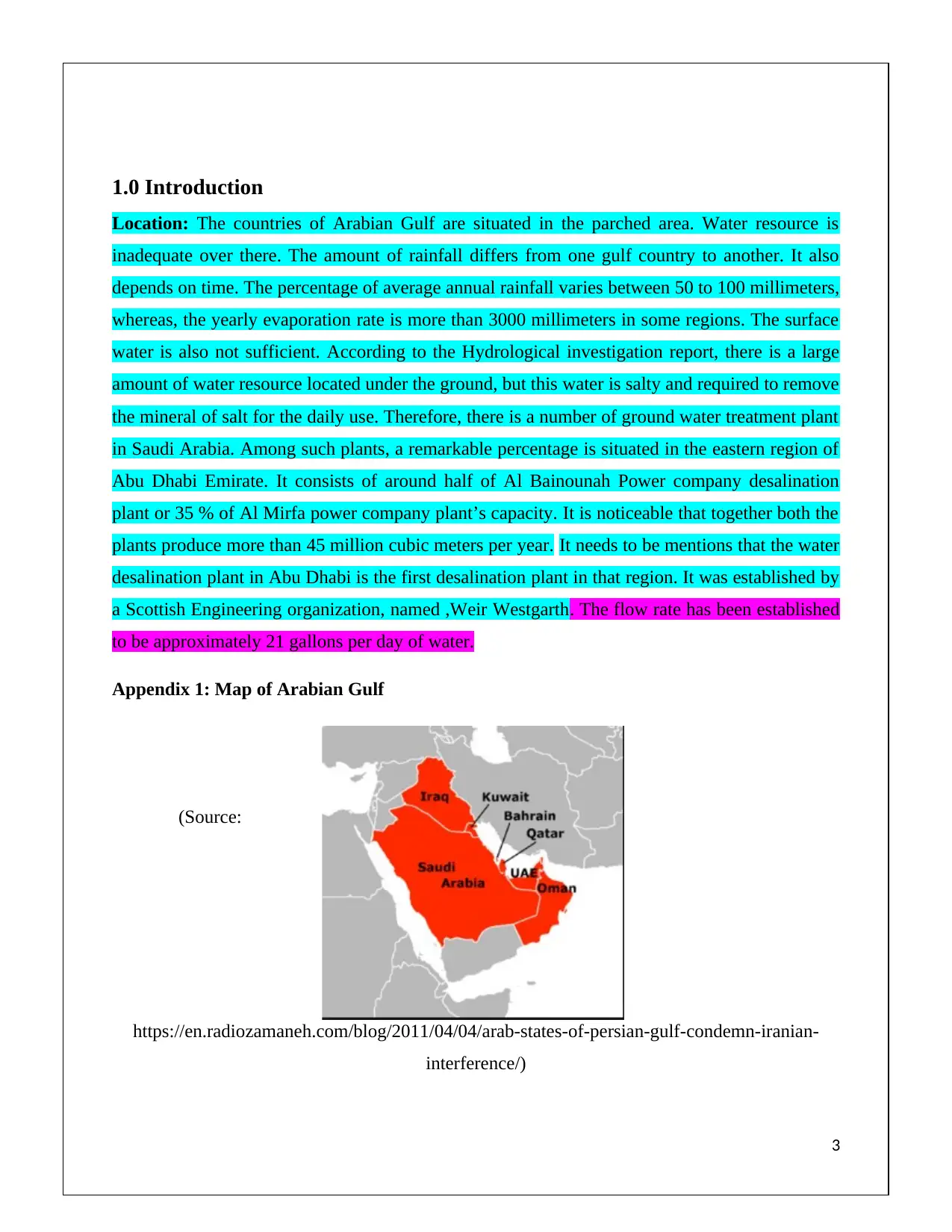
1.0 Introduction
Location: The countries of Arabian Gulf are situated in the parched area. Water resource is
inadequate over there. The amount of rainfall differs from one gulf country to another. It also
depends on time. The percentage of average annual rainfall varies between 50 to 100 millimeters,
whereas, the yearly evaporation rate is more than 3000 millimeters in some regions. The surface
water is also not sufficient. According to the Hydrological investigation report, there is a large
amount of water resource located under the ground, but this water is salty and required to remove
the mineral of salt for the daily use. Therefore, there is a number of ground water treatment plant
in Saudi Arabia. Among such plants, a remarkable percentage is situated in the eastern region of
Abu Dhabi Emirate. It consists of around half of Al Bainounah Power company desalination
plant or 35 % of Al Mirfa power company plant’s capacity. It is noticeable that together both the
plants produce more than 45 million cubic meters per year. It needs to be mentions that the water
desalination plant in Abu Dhabi is the first desalination plant in that region. It was established by
a Scottish Engineering organization, named ,Weir Westgarth. The flow rate has been established
to be approximately 21 gallons per day of water.
Appendix 1: Map of Arabian Gulf
(Source:
https://en.radiozamaneh.com/blog/2011/04/04/arab-states-of-persian-gulf-condemn-iranian-
interference/)
3
Location: The countries of Arabian Gulf are situated in the parched area. Water resource is
inadequate over there. The amount of rainfall differs from one gulf country to another. It also
depends on time. The percentage of average annual rainfall varies between 50 to 100 millimeters,
whereas, the yearly evaporation rate is more than 3000 millimeters in some regions. The surface
water is also not sufficient. According to the Hydrological investigation report, there is a large
amount of water resource located under the ground, but this water is salty and required to remove
the mineral of salt for the daily use. Therefore, there is a number of ground water treatment plant
in Saudi Arabia. Among such plants, a remarkable percentage is situated in the eastern region of
Abu Dhabi Emirate. It consists of around half of Al Bainounah Power company desalination
plant or 35 % of Al Mirfa power company plant’s capacity. It is noticeable that together both the
plants produce more than 45 million cubic meters per year. It needs to be mentions that the water
desalination plant in Abu Dhabi is the first desalination plant in that region. It was established by
a Scottish Engineering organization, named ,Weir Westgarth. The flow rate has been established
to be approximately 21 gallons per day of water.
Appendix 1: Map of Arabian Gulf
(Source:
https://en.radiozamaneh.com/blog/2011/04/04/arab-states-of-persian-gulf-condemn-iranian-
interference/)
3
⊘ This is a preview!⊘
Do you want full access?
Subscribe today to unlock all pages.

Trusted by 1+ million students worldwide
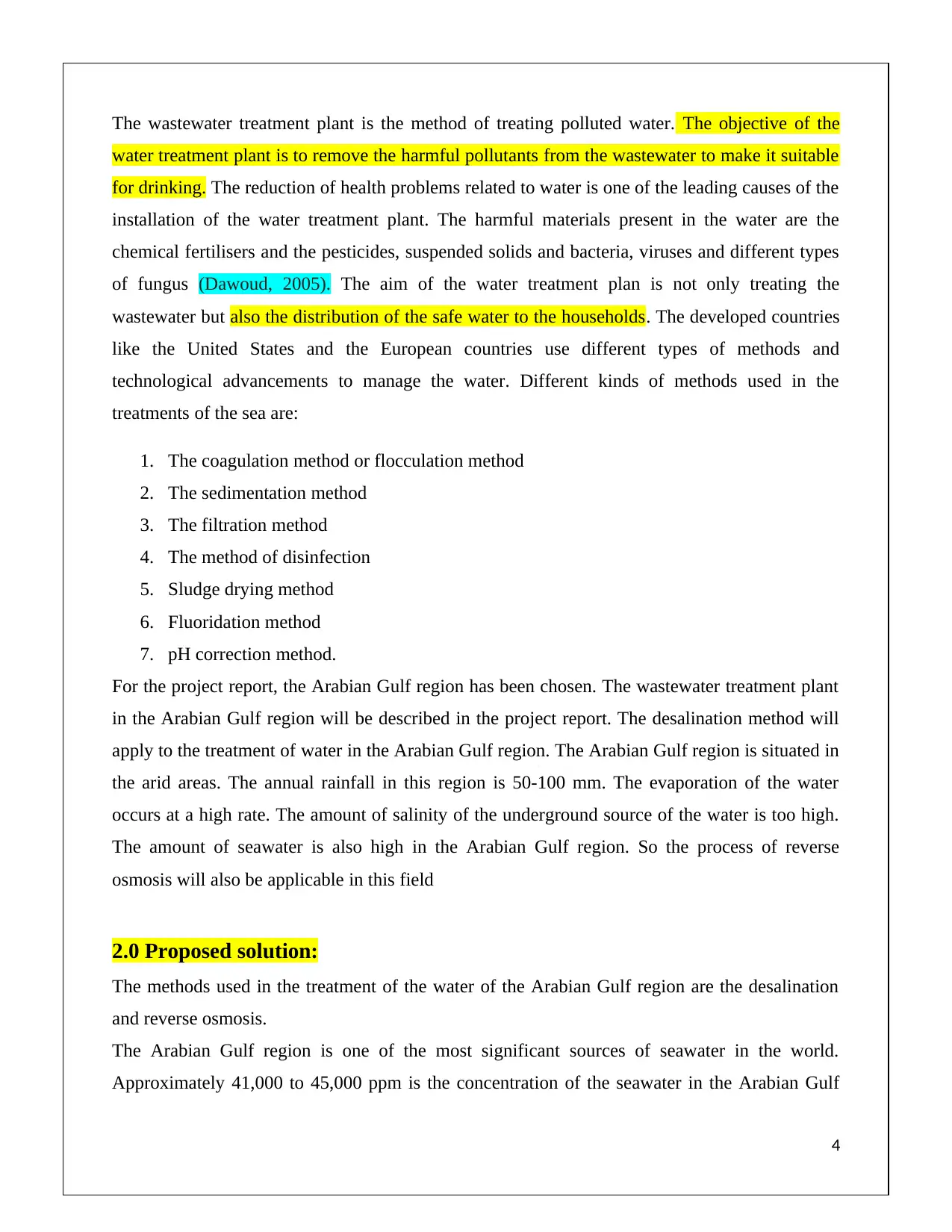
The wastewater treatment plant is the method of treating polluted water. The objective of the
water treatment plant is to remove the harmful pollutants from the wastewater to make it suitable
for drinking. The reduction of health problems related to water is one of the leading causes of the
installation of the water treatment plant. The harmful materials present in the water are the
chemical fertilisers and the pesticides, suspended solids and bacteria, viruses and different types
of fungus (Dawoud, 2005). The aim of the water treatment plan is not only treating the
wastewater but also the distribution of the safe water to the households. The developed countries
like the United States and the European countries use different types of methods and
technological advancements to manage the water. Different kinds of methods used in the
treatments of the sea are:
1. The coagulation method or flocculation method
2. The sedimentation method
3. The filtration method
4. The method of disinfection
5. Sludge drying method
6. Fluoridation method
7. pH correction method.
For the project report, the Arabian Gulf region has been chosen. The wastewater treatment plant
in the Arabian Gulf region will be described in the project report. The desalination method will
apply to the treatment of water in the Arabian Gulf region. The Arabian Gulf region is situated in
the arid areas. The annual rainfall in this region is 50-100 mm. The evaporation of the water
occurs at a high rate. The amount of salinity of the underground source of the water is too high.
The amount of seawater is also high in the Arabian Gulf region. So the process of reverse
osmosis will also be applicable in this field
2.0 Proposed solution:
The methods used in the treatment of the water of the Arabian Gulf region are the desalination
and reverse osmosis.
The Arabian Gulf region is one of the most significant sources of seawater in the world.
Approximately 41,000 to 45,000 ppm is the concentration of the seawater in the Arabian Gulf
4
water treatment plant is to remove the harmful pollutants from the wastewater to make it suitable
for drinking. The reduction of health problems related to water is one of the leading causes of the
installation of the water treatment plant. The harmful materials present in the water are the
chemical fertilisers and the pesticides, suspended solids and bacteria, viruses and different types
of fungus (Dawoud, 2005). The aim of the water treatment plan is not only treating the
wastewater but also the distribution of the safe water to the households. The developed countries
like the United States and the European countries use different types of methods and
technological advancements to manage the water. Different kinds of methods used in the
treatments of the sea are:
1. The coagulation method or flocculation method
2. The sedimentation method
3. The filtration method
4. The method of disinfection
5. Sludge drying method
6. Fluoridation method
7. pH correction method.
For the project report, the Arabian Gulf region has been chosen. The wastewater treatment plant
in the Arabian Gulf region will be described in the project report. The desalination method will
apply to the treatment of water in the Arabian Gulf region. The Arabian Gulf region is situated in
the arid areas. The annual rainfall in this region is 50-100 mm. The evaporation of the water
occurs at a high rate. The amount of salinity of the underground source of the water is too high.
The amount of seawater is also high in the Arabian Gulf region. So the process of reverse
osmosis will also be applicable in this field
2.0 Proposed solution:
The methods used in the treatment of the water of the Arabian Gulf region are the desalination
and reverse osmosis.
The Arabian Gulf region is one of the most significant sources of seawater in the world.
Approximately 41,000 to 45,000 ppm is the concentration of the seawater in the Arabian Gulf
4
Paraphrase This Document
Need a fresh take? Get an instant paraphrase of this document with our AI Paraphraser
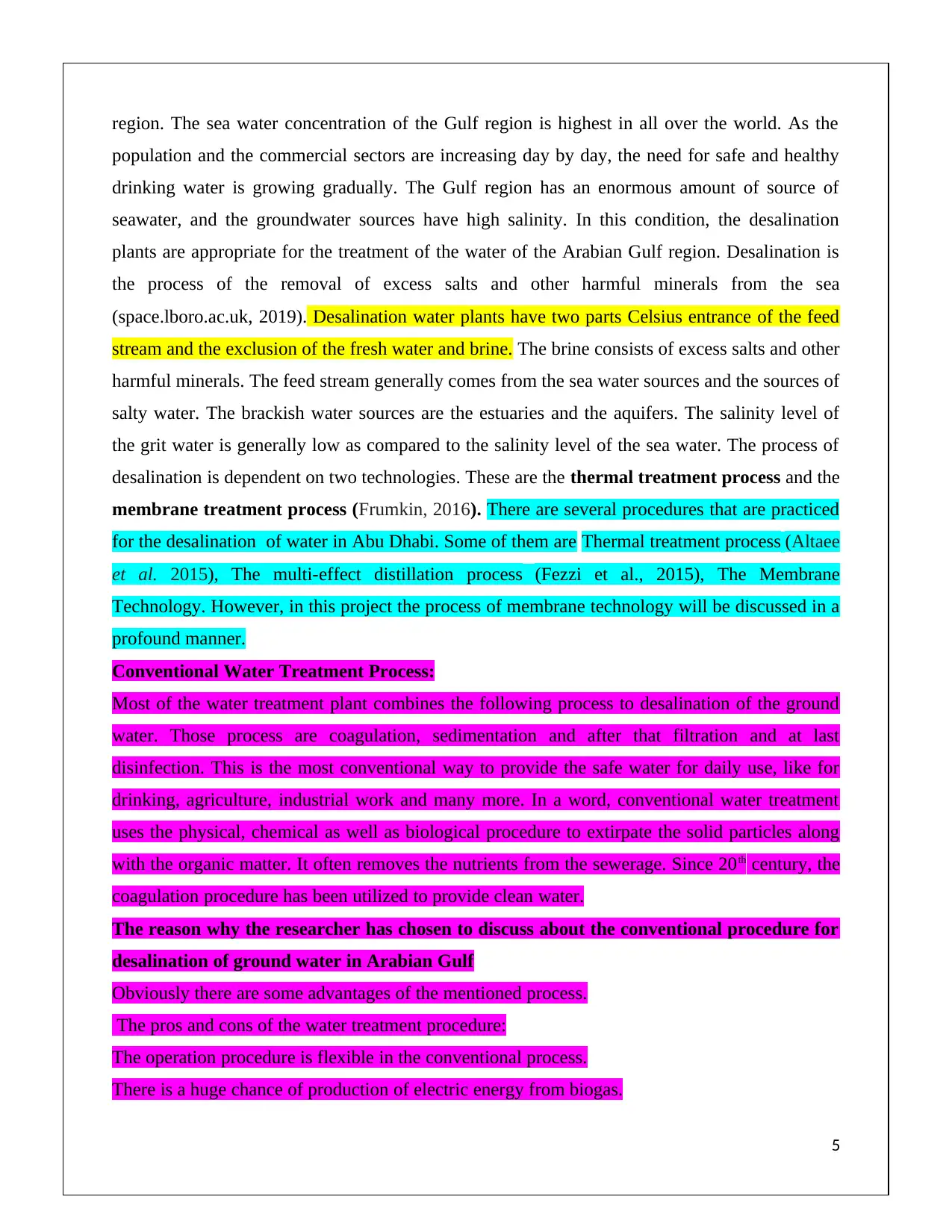
region. The sea water concentration of the Gulf region is highest in all over the world. As the
population and the commercial sectors are increasing day by day, the need for safe and healthy
drinking water is growing gradually. The Gulf region has an enormous amount of source of
seawater, and the groundwater sources have high salinity. In this condition, the desalination
plants are appropriate for the treatment of the water of the Arabian Gulf region. Desalination is
the process of the removal of excess salts and other harmful minerals from the sea
(space.lboro.ac.uk, 2019). Desalination water plants have two parts Celsius entrance of the feed
stream and the exclusion of the fresh water and brine. The brine consists of excess salts and other
harmful minerals. The feed stream generally comes from the sea water sources and the sources of
salty water. The brackish water sources are the estuaries and the aquifers. The salinity level of
the grit water is generally low as compared to the salinity level of the sea water. The process of
desalination is dependent on two technologies. These are the thermal treatment process and the
membrane treatment process (Frumkin, 2016). There are several procedures that are practiced
for the desalination of water in Abu Dhabi. Some of them are Thermal treatment process (Altaee
et al. 2015), The multi-effect distillation process (Fezzi et al., 2015), The Membrane
Technology. However, in this project the process of membrane technology will be discussed in a
profound manner.
Conventional Water Treatment Process:
Most of the water treatment plant combines the following process to desalination of the ground
water. Those process are coagulation, sedimentation and after that filtration and at last
disinfection. This is the most conventional way to provide the safe water for daily use, like for
drinking, agriculture, industrial work and many more. In a word, conventional water treatment
uses the physical, chemical as well as biological procedure to extirpate the solid particles along
with the organic matter. It often removes the nutrients from the sewerage. Since 20th century, the
coagulation procedure has been utilized to provide clean water.
The reason why the researcher has chosen to discuss about the conventional procedure for
desalination of ground water in Arabian Gulf
Obviously there are some advantages of the mentioned process.
The pros and cons of the water treatment procedure:
The operation procedure is flexible in the conventional process.
There is a huge chance of production of electric energy from biogas.
5
population and the commercial sectors are increasing day by day, the need for safe and healthy
drinking water is growing gradually. The Gulf region has an enormous amount of source of
seawater, and the groundwater sources have high salinity. In this condition, the desalination
plants are appropriate for the treatment of the water of the Arabian Gulf region. Desalination is
the process of the removal of excess salts and other harmful minerals from the sea
(space.lboro.ac.uk, 2019). Desalination water plants have two parts Celsius entrance of the feed
stream and the exclusion of the fresh water and brine. The brine consists of excess salts and other
harmful minerals. The feed stream generally comes from the sea water sources and the sources of
salty water. The brackish water sources are the estuaries and the aquifers. The salinity level of
the grit water is generally low as compared to the salinity level of the sea water. The process of
desalination is dependent on two technologies. These are the thermal treatment process and the
membrane treatment process (Frumkin, 2016). There are several procedures that are practiced
for the desalination of water in Abu Dhabi. Some of them are Thermal treatment process (Altaee
et al. 2015), The multi-effect distillation process (Fezzi et al., 2015), The Membrane
Technology. However, in this project the process of membrane technology will be discussed in a
profound manner.
Conventional Water Treatment Process:
Most of the water treatment plant combines the following process to desalination of the ground
water. Those process are coagulation, sedimentation and after that filtration and at last
disinfection. This is the most conventional way to provide the safe water for daily use, like for
drinking, agriculture, industrial work and many more. In a word, conventional water treatment
uses the physical, chemical as well as biological procedure to extirpate the solid particles along
with the organic matter. It often removes the nutrients from the sewerage. Since 20th century, the
coagulation procedure has been utilized to provide clean water.
The reason why the researcher has chosen to discuss about the conventional procedure for
desalination of ground water in Arabian Gulf
Obviously there are some advantages of the mentioned process.
The pros and cons of the water treatment procedure:
The operation procedure is flexible in the conventional process.
There is a huge chance of production of electric energy from biogas.
5
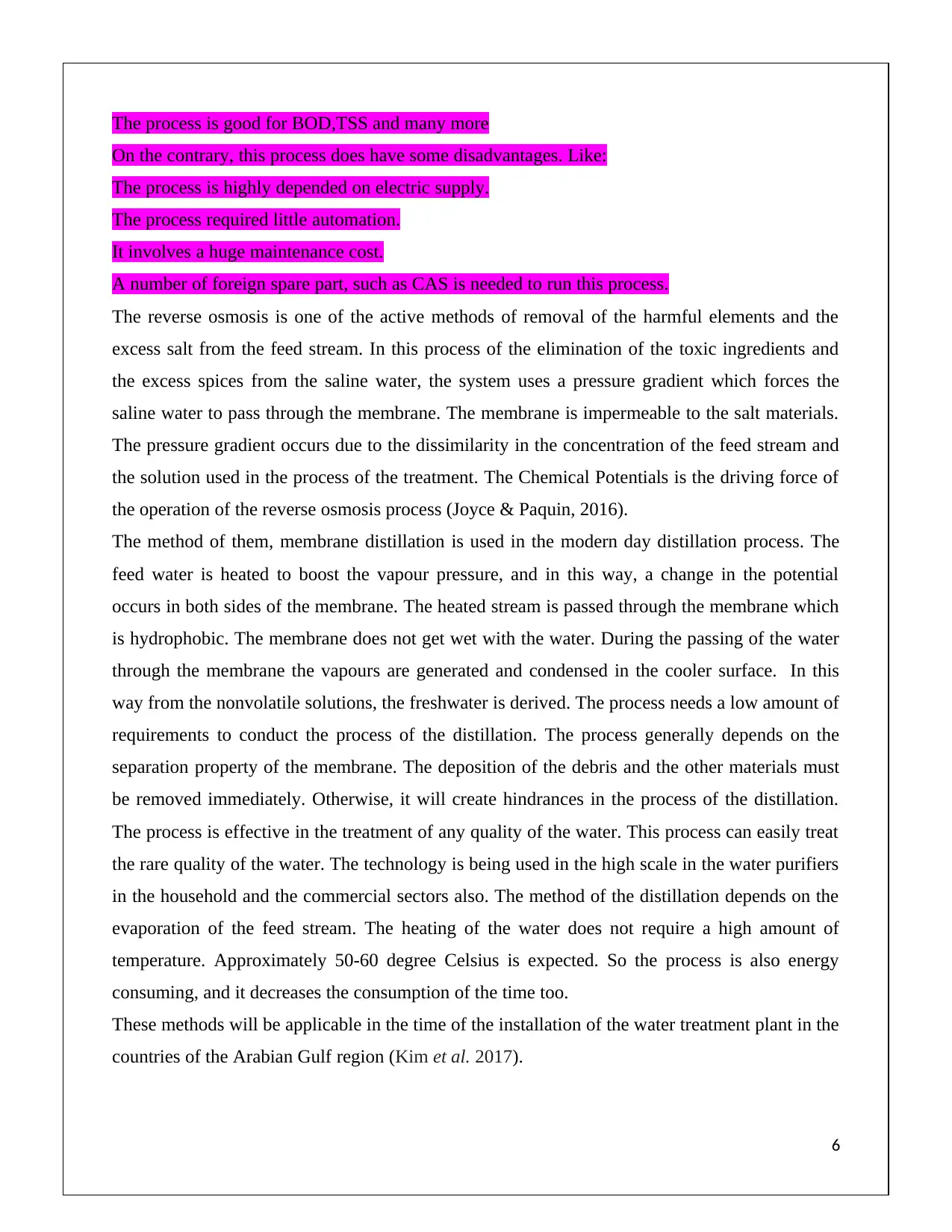
The process is good for BOD,TSS and many more
On the contrary, this process does have some disadvantages. Like:
The process is highly depended on electric supply.
The process required little automation.
It involves a huge maintenance cost.
A number of foreign spare part, such as CAS is needed to run this process.
The reverse osmosis is one of the active methods of removal of the harmful elements and the
excess salt from the feed stream. In this process of the elimination of the toxic ingredients and
the excess spices from the saline water, the system uses a pressure gradient which forces the
saline water to pass through the membrane. The membrane is impermeable to the salt materials.
The pressure gradient occurs due to the dissimilarity in the concentration of the feed stream and
the solution used in the process of the treatment. The Chemical Potentials is the driving force of
the operation of the reverse osmosis process (Joyce & Paquin, 2016).
The method of them, membrane distillation is used in the modern day distillation process. The
feed water is heated to boost the vapour pressure, and in this way, a change in the potential
occurs in both sides of the membrane. The heated stream is passed through the membrane which
is hydrophobic. The membrane does not get wet with the water. During the passing of the water
through the membrane the vapours are generated and condensed in the cooler surface. In this
way from the nonvolatile solutions, the freshwater is derived. The process needs a low amount of
requirements to conduct the process of the distillation. The process generally depends on the
separation property of the membrane. The deposition of the debris and the other materials must
be removed immediately. Otherwise, it will create hindrances in the process of the distillation.
The process is effective in the treatment of any quality of the water. This process can easily treat
the rare quality of the water. The technology is being used in the high scale in the water purifiers
in the household and the commercial sectors also. The method of the distillation depends on the
evaporation of the feed stream. The heating of the water does not require a high amount of
temperature. Approximately 50-60 degree Celsius is expected. So the process is also energy
consuming, and it decreases the consumption of the time too.
These methods will be applicable in the time of the installation of the water treatment plant in the
countries of the Arabian Gulf region (Kim et al. 2017).
6
On the contrary, this process does have some disadvantages. Like:
The process is highly depended on electric supply.
The process required little automation.
It involves a huge maintenance cost.
A number of foreign spare part, such as CAS is needed to run this process.
The reverse osmosis is one of the active methods of removal of the harmful elements and the
excess salt from the feed stream. In this process of the elimination of the toxic ingredients and
the excess spices from the saline water, the system uses a pressure gradient which forces the
saline water to pass through the membrane. The membrane is impermeable to the salt materials.
The pressure gradient occurs due to the dissimilarity in the concentration of the feed stream and
the solution used in the process of the treatment. The Chemical Potentials is the driving force of
the operation of the reverse osmosis process (Joyce & Paquin, 2016).
The method of them, membrane distillation is used in the modern day distillation process. The
feed water is heated to boost the vapour pressure, and in this way, a change in the potential
occurs in both sides of the membrane. The heated stream is passed through the membrane which
is hydrophobic. The membrane does not get wet with the water. During the passing of the water
through the membrane the vapours are generated and condensed in the cooler surface. In this
way from the nonvolatile solutions, the freshwater is derived. The process needs a low amount of
requirements to conduct the process of the distillation. The process generally depends on the
separation property of the membrane. The deposition of the debris and the other materials must
be removed immediately. Otherwise, it will create hindrances in the process of the distillation.
The process is effective in the treatment of any quality of the water. This process can easily treat
the rare quality of the water. The technology is being used in the high scale in the water purifiers
in the household and the commercial sectors also. The method of the distillation depends on the
evaporation of the feed stream. The heating of the water does not require a high amount of
temperature. Approximately 50-60 degree Celsius is expected. So the process is also energy
consuming, and it decreases the consumption of the time too.
These methods will be applicable in the time of the installation of the water treatment plant in the
countries of the Arabian Gulf region (Kim et al. 2017).
6
⊘ This is a preview!⊘
Do you want full access?
Subscribe today to unlock all pages.

Trusted by 1+ million students worldwide
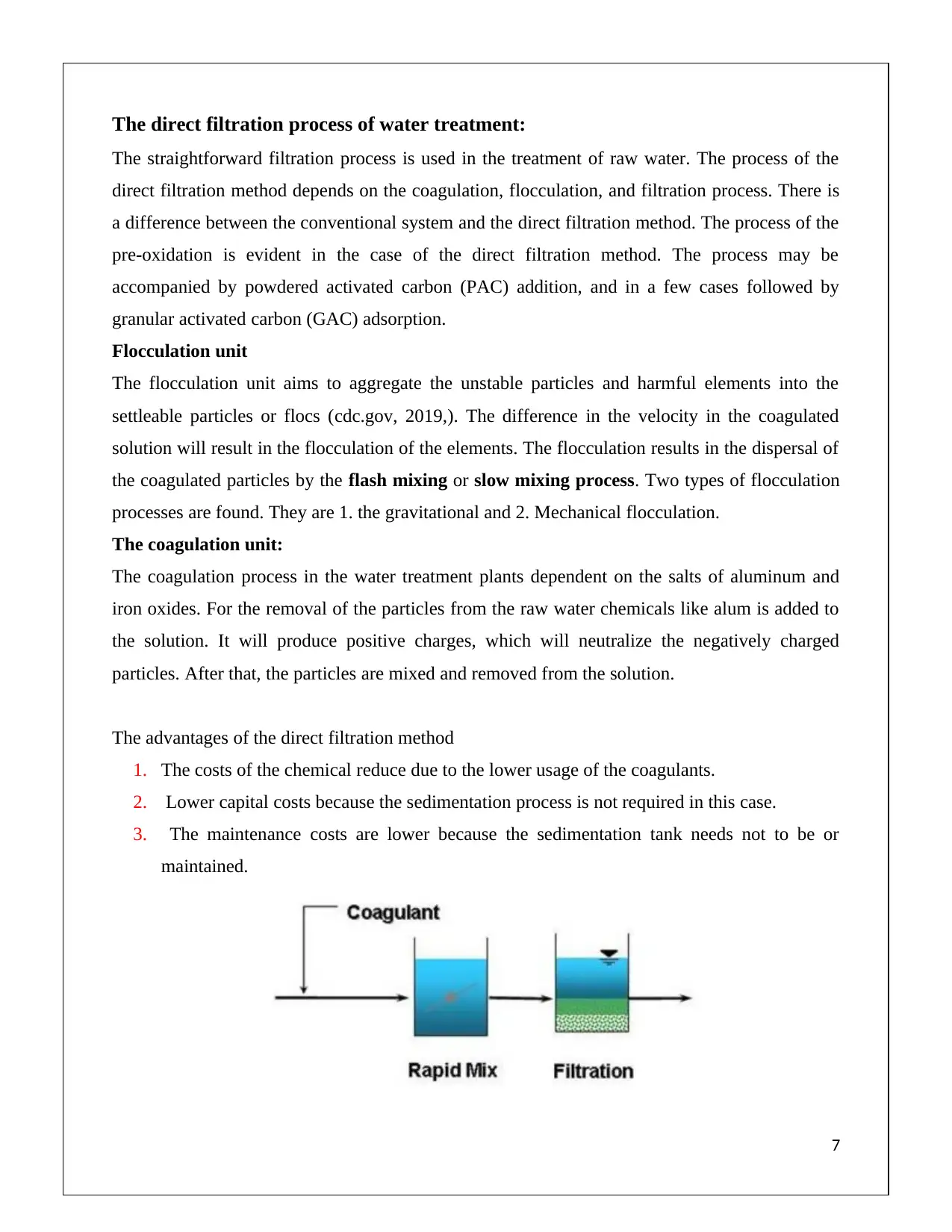
The direct filtration process of water treatment:
The straightforward filtration process is used in the treatment of raw water. The process of the
direct filtration method depends on the coagulation, flocculation, and filtration process. There is
a difference between the conventional system and the direct filtration method. The process of the
pre-oxidation is evident in the case of the direct filtration method. The process may be
accompanied by powdered activated carbon (PAC) addition, and in a few cases followed by
granular activated carbon (GAC) adsorption.
Flocculation unit
The flocculation unit aims to aggregate the unstable particles and harmful elements into the
settleable particles or flocs (cdc.gov, 2019,). The difference in the velocity in the coagulated
solution will result in the flocculation of the elements. The flocculation results in the dispersal of
the coagulated particles by the flash mixing or slow mixing process. Two types of flocculation
processes are found. They are 1. the gravitational and 2. Mechanical flocculation.
The coagulation unit:
The coagulation process in the water treatment plants dependent on the salts of aluminum and
iron oxides. For the removal of the particles from the raw water chemicals like alum is added to
the solution. It will produce positive charges, which will neutralize the negatively charged
particles. After that, the particles are mixed and removed from the solution.
The advantages of the direct filtration method
1. The costs of the chemical reduce due to the lower usage of the coagulants.
2. Lower capital costs because the sedimentation process is not required in this case.
3. The maintenance costs are lower because the sedimentation tank needs not to be or
maintained.
7
The straightforward filtration process is used in the treatment of raw water. The process of the
direct filtration method depends on the coagulation, flocculation, and filtration process. There is
a difference between the conventional system and the direct filtration method. The process of the
pre-oxidation is evident in the case of the direct filtration method. The process may be
accompanied by powdered activated carbon (PAC) addition, and in a few cases followed by
granular activated carbon (GAC) adsorption.
Flocculation unit
The flocculation unit aims to aggregate the unstable particles and harmful elements into the
settleable particles or flocs (cdc.gov, 2019,). The difference in the velocity in the coagulated
solution will result in the flocculation of the elements. The flocculation results in the dispersal of
the coagulated particles by the flash mixing or slow mixing process. Two types of flocculation
processes are found. They are 1. the gravitational and 2. Mechanical flocculation.
The coagulation unit:
The coagulation process in the water treatment plants dependent on the salts of aluminum and
iron oxides. For the removal of the particles from the raw water chemicals like alum is added to
the solution. It will produce positive charges, which will neutralize the negatively charged
particles. After that, the particles are mixed and removed from the solution.
The advantages of the direct filtration method
1. The costs of the chemical reduce due to the lower usage of the coagulants.
2. Lower capital costs because the sedimentation process is not required in this case.
3. The maintenance costs are lower because the sedimentation tank needs not to be or
maintained.
7
Paraphrase This Document
Need a fresh take? Get an instant paraphrase of this document with our AI Paraphraser
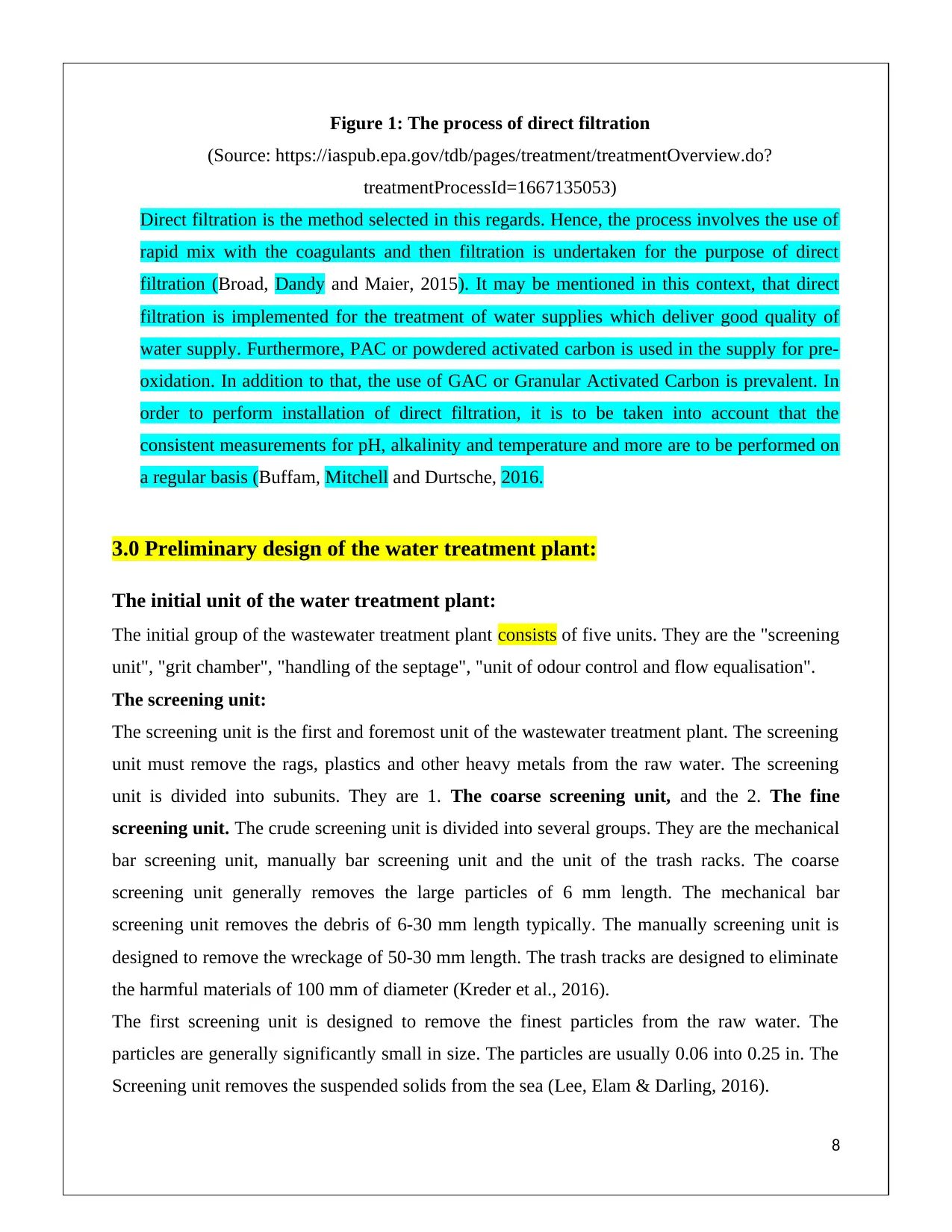
Figure 1: The process of direct filtration
(Source: https://iaspub.epa.gov/tdb/pages/treatment/treatmentOverview.do?
treatmentProcessId=1667135053)
Direct filtration is the method selected in this regards. Hence, the process involves the use of
rapid mix with the coagulants and then filtration is undertaken for the purpose of direct
filtration (Broad, Dandy and Maier, 2015). It may be mentioned in this context, that direct
filtration is implemented for the treatment of water supplies which deliver good quality of
water supply. Furthermore, PAC or powdered activated carbon is used in the supply for pre-
oxidation. In addition to that, the use of GAC or Granular Activated Carbon is prevalent. In
order to perform installation of direct filtration, it is to be taken into account that the
consistent measurements for pH, alkalinity and temperature and more are to be performed on
a regular basis (Buffam, Mitchell and Durtsche, 2016.
3.0 Preliminary design of the water treatment plant:
The initial unit of the water treatment plant:
The initial group of the wastewater treatment plant consists of five units. They are the "screening
unit", "grit chamber", "handling of the septage", "unit of odour control and flow equalisation".
The screening unit:
The screening unit is the first and foremost unit of the wastewater treatment plant. The screening
unit must remove the rags, plastics and other heavy metals from the raw water. The screening
unit is divided into subunits. They are 1. The coarse screening unit, and the 2. The fine
screening unit. The crude screening unit is divided into several groups. They are the mechanical
bar screening unit, manually bar screening unit and the unit of the trash racks. The coarse
screening unit generally removes the large particles of 6 mm length. The mechanical bar
screening unit removes the debris of 6-30 mm length typically. The manually screening unit is
designed to remove the wreckage of 50-30 mm length. The trash tracks are designed to eliminate
the harmful materials of 100 mm of diameter (Kreder et al., 2016).
The first screening unit is designed to remove the finest particles from the raw water. The
particles are generally significantly small in size. The particles are usually 0.06 into 0.25 in. The
Screening unit removes the suspended solids from the sea (Lee, Elam & Darling, 2016).
8
(Source: https://iaspub.epa.gov/tdb/pages/treatment/treatmentOverview.do?
treatmentProcessId=1667135053)
Direct filtration is the method selected in this regards. Hence, the process involves the use of
rapid mix with the coagulants and then filtration is undertaken for the purpose of direct
filtration (Broad, Dandy and Maier, 2015). It may be mentioned in this context, that direct
filtration is implemented for the treatment of water supplies which deliver good quality of
water supply. Furthermore, PAC or powdered activated carbon is used in the supply for pre-
oxidation. In addition to that, the use of GAC or Granular Activated Carbon is prevalent. In
order to perform installation of direct filtration, it is to be taken into account that the
consistent measurements for pH, alkalinity and temperature and more are to be performed on
a regular basis (Buffam, Mitchell and Durtsche, 2016.
3.0 Preliminary design of the water treatment plant:
The initial unit of the water treatment plant:
The initial group of the wastewater treatment plant consists of five units. They are the "screening
unit", "grit chamber", "handling of the septage", "unit of odour control and flow equalisation".
The screening unit:
The screening unit is the first and foremost unit of the wastewater treatment plant. The screening
unit must remove the rags, plastics and other heavy metals from the raw water. The screening
unit is divided into subunits. They are 1. The coarse screening unit, and the 2. The fine
screening unit. The crude screening unit is divided into several groups. They are the mechanical
bar screening unit, manually bar screening unit and the unit of the trash racks. The coarse
screening unit generally removes the large particles of 6 mm length. The mechanical bar
screening unit removes the debris of 6-30 mm length typically. The manually screening unit is
designed to remove the wreckage of 50-30 mm length. The trash tracks are designed to eliminate
the harmful materials of 100 mm of diameter (Kreder et al., 2016).
The first screening unit is designed to remove the finest particles from the raw water. The
particles are generally significantly small in size. The particles are usually 0.06 into 0.25 in. The
Screening unit removes the suspended solids from the sea (Lee, Elam & Darling, 2016).
8

The design of a Water Treatment Plant has been illustrated in Figure 2 presented below.
9
9
⊘ This is a preview!⊘
Do you want full access?
Subscribe today to unlock all pages.

Trusted by 1+ million students worldwide
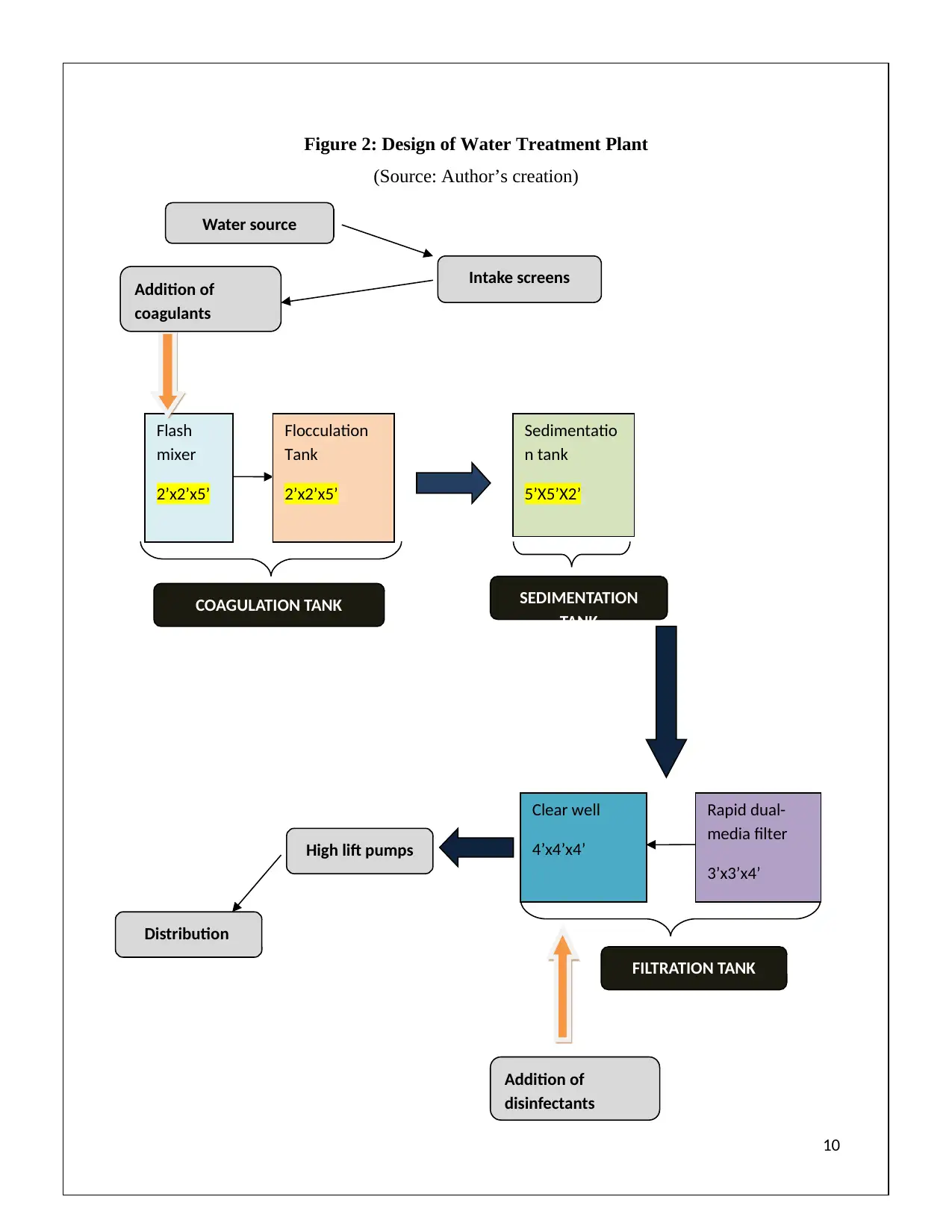
Figure 2: Design of Water Treatment Plant
(Source: Author’s creation)
10
Flash
mixer
2’x2’x5’
Flocculation
Tank
2’x2’x5’
COAGULATION TANK
Sedimentatio
n tank
5’X5’X2’
Addition of
coagulants
Water source
Intake screens
SEDIMENTATION
TANK
Clear well
4’x4’x4’
Rapid dual-
media filter
3’x3’x4’
FILTRATION TANK
Addition of
disinfectants
High lift pumps
Distribution
(Source: Author’s creation)
10
Flash
mixer
2’x2’x5’
Flocculation
Tank
2’x2’x5’
COAGULATION TANK
Sedimentatio
n tank
5’X5’X2’
Addition of
coagulants
Water source
Intake screens
SEDIMENTATION
TANK
Clear well
4’x4’x4’
Rapid dual-
media filter
3’x3’x4’
FILTRATION TANK
Addition of
disinfectants
High lift pumps
Distribution
Paraphrase This Document
Need a fresh take? Get an instant paraphrase of this document with our AI Paraphraser
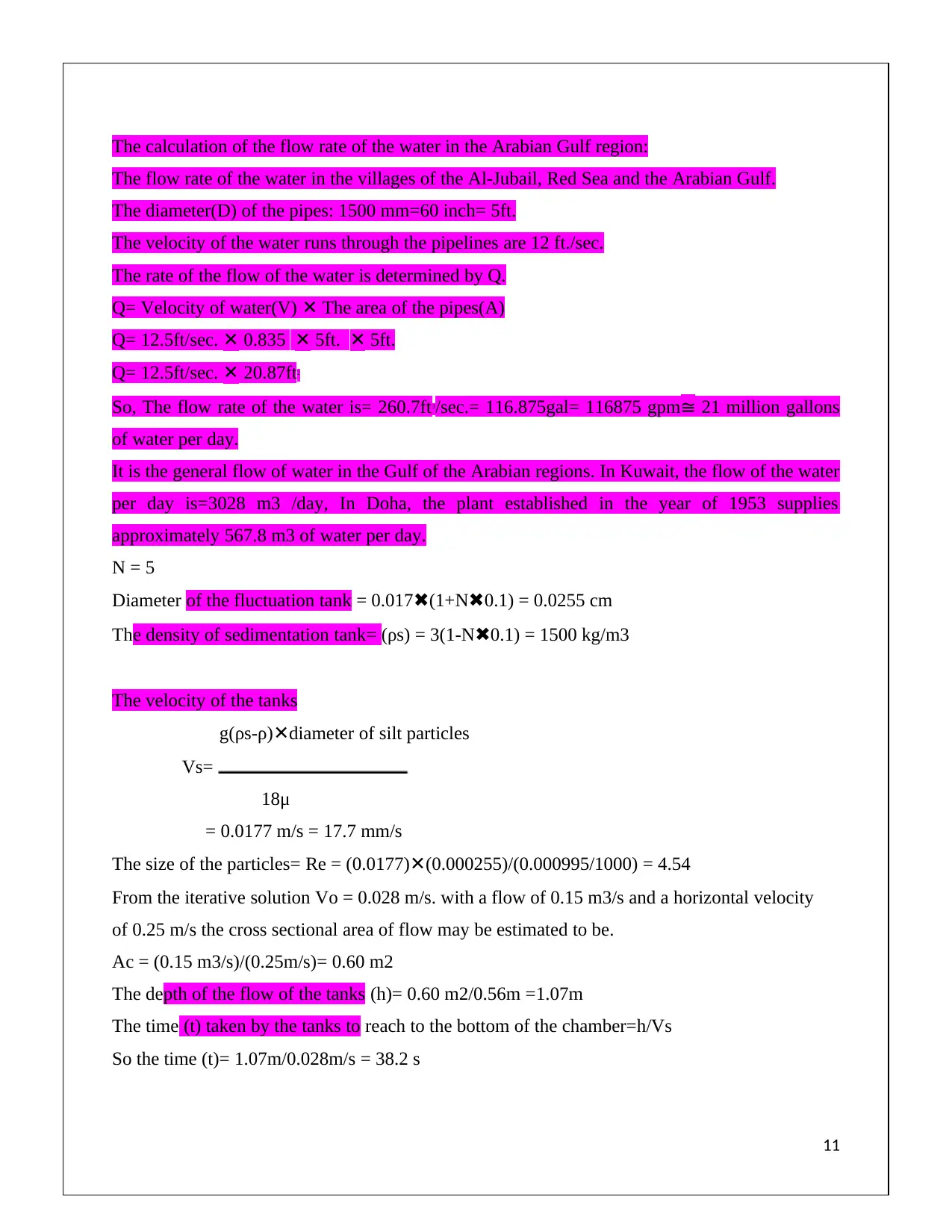
The calculation of the flow rate of the water in the Arabian Gulf region:
The flow rate of the water in the villages of the Al-Jubail, Red Sea and the Arabian Gulf.
The diameter(D) of the pipes: 1500 mm=60 inch= 5ft.
The velocity of the water runs through the pipelines are 12 ft./sec.
The rate of the flow of the water is determined by Q.
Q= Velocity of water(V) ✕ The area of the pipes(A)
Q= 12.5ft/sec. ✕ 0.835 ✕ 5ft. ✕ 5ft.
Q= 12.5ft/sec. ✕ 20.87ft2
So, The flow rate of the water is= 260.7ft3/sec.= 116.875gal= 116875 gpm≅ 21 million gallons
of water per day.
It is the general flow of water in the Gulf of the Arabian regions. In Kuwait, the flow of the water
per day is=3028 m3 /day, In Doha, the plant established in the year of 1953 supplies
approximately 567.8 m3 of water per day.
N = 5
Diameter of the fluctuation tank = 0.017✖(1+N✖0.1) = 0.0255 cm
The density of sedimentation tank= (ρs) = 3(1-N✖0.1) = 1500 kg/m3
The velocity of the tanks
g(ρs-ρ)✕diameter of silt particles
Vs=
18μ
= 0.0177 m/s = 17.7 mm/s
The size of the particles= Re = (0.0177)✕(0.000255)/(0.000995/1000) = 4.54
From the iterative solution Vo = 0.028 m/s. with a flow of 0.15 m3/s and a horizontal velocity
of 0.25 m/s the cross sectional area of flow may be estimated to be.
Ac = (0.15 m3/s)/(0.25m/s)= 0.60 m2
The depth of the flow of the tanks (h)= 0.60 m2/0.56m =1.07m
The time (t) taken by the tanks to reach to the bottom of the chamber=h/Vs
So the time (t)= 1.07m/0.028m/s = 38.2 s
11
The flow rate of the water in the villages of the Al-Jubail, Red Sea and the Arabian Gulf.
The diameter(D) of the pipes: 1500 mm=60 inch= 5ft.
The velocity of the water runs through the pipelines are 12 ft./sec.
The rate of the flow of the water is determined by Q.
Q= Velocity of water(V) ✕ The area of the pipes(A)
Q= 12.5ft/sec. ✕ 0.835 ✕ 5ft. ✕ 5ft.
Q= 12.5ft/sec. ✕ 20.87ft2
So, The flow rate of the water is= 260.7ft3/sec.= 116.875gal= 116875 gpm≅ 21 million gallons
of water per day.
It is the general flow of water in the Gulf of the Arabian regions. In Kuwait, the flow of the water
per day is=3028 m3 /day, In Doha, the plant established in the year of 1953 supplies
approximately 567.8 m3 of water per day.
N = 5
Diameter of the fluctuation tank = 0.017✖(1+N✖0.1) = 0.0255 cm
The density of sedimentation tank= (ρs) = 3(1-N✖0.1) = 1500 kg/m3
The velocity of the tanks
g(ρs-ρ)✕diameter of silt particles
Vs=
18μ
= 0.0177 m/s = 17.7 mm/s
The size of the particles= Re = (0.0177)✕(0.000255)/(0.000995/1000) = 4.54
From the iterative solution Vo = 0.028 m/s. with a flow of 0.15 m3/s and a horizontal velocity
of 0.25 m/s the cross sectional area of flow may be estimated to be.
Ac = (0.15 m3/s)/(0.25m/s)= 0.60 m2
The depth of the flow of the tanks (h)= 0.60 m2/0.56m =1.07m
The time (t) taken by the tanks to reach to the bottom of the chamber=h/Vs
So the time (t)= 1.07m/0.028m/s = 38.2 s
11
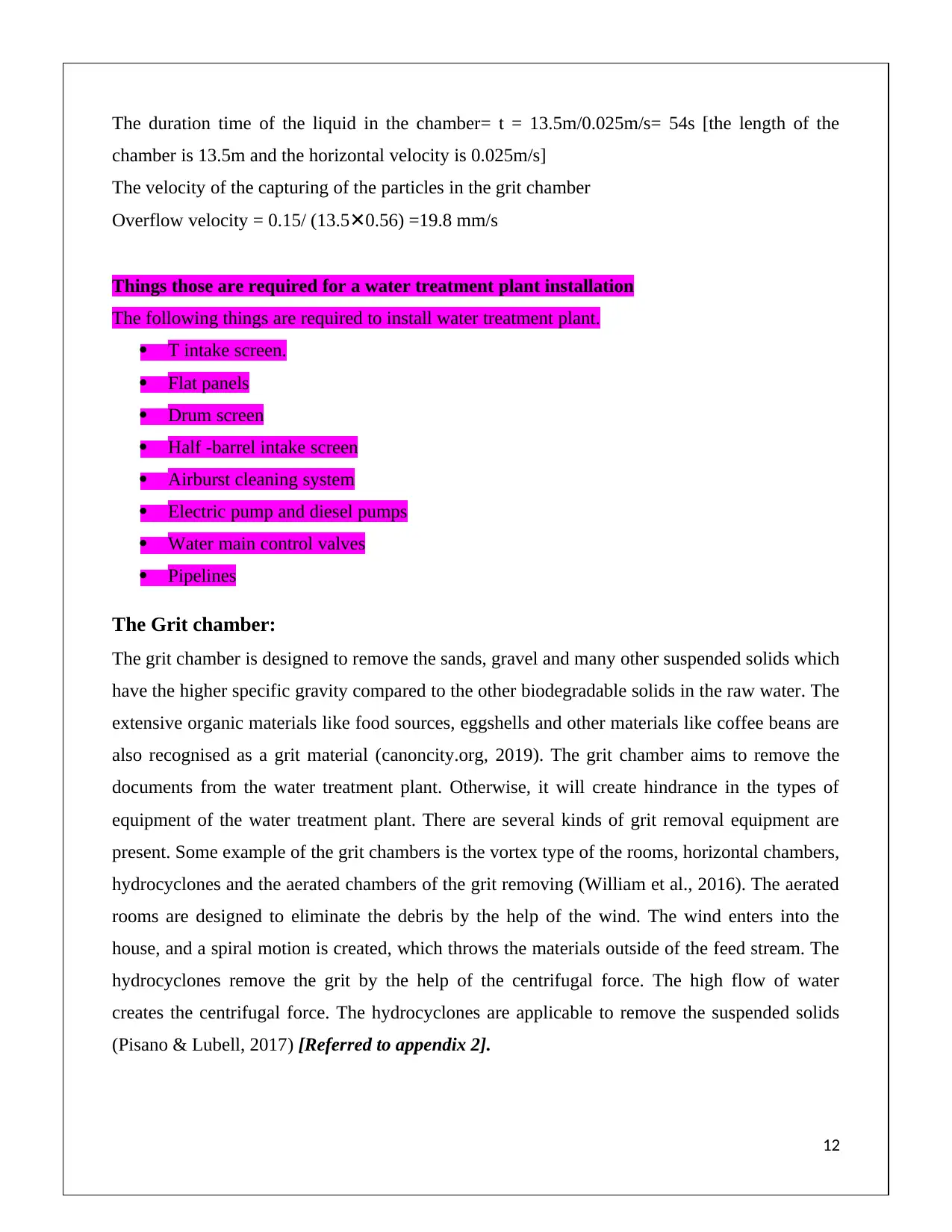
The duration time of the liquid in the chamber= t = 13.5m/0.025m/s= 54s [the length of the
chamber is 13.5m and the horizontal velocity is 0.025m/s]
The velocity of the capturing of the particles in the grit chamber
Overflow velocity = 0.15/ (13.5✕0.56) =19.8 mm/s
Things those are required for a water treatment plant installation
The following things are required to install water treatment plant.
T intake screen.
Flat panels
Drum screen
Half -barrel intake screen
Airburst cleaning system
Electric pump and diesel pumps
Water main control valves
Pipelines
The Grit chamber:
The grit chamber is designed to remove the sands, gravel and many other suspended solids which
have the higher specific gravity compared to the other biodegradable solids in the raw water. The
extensive organic materials like food sources, eggshells and other materials like coffee beans are
also recognised as a grit material (canoncity.org, 2019). The grit chamber aims to remove the
documents from the water treatment plant. Otherwise, it will create hindrance in the types of
equipment of the water treatment plant. There are several kinds of grit removal equipment are
present. Some example of the grit chambers is the vortex type of the rooms, horizontal chambers,
hydrocyclones and the aerated chambers of the grit removing (William et al., 2016). The aerated
rooms are designed to eliminate the debris by the help of the wind. The wind enters into the
house, and a spiral motion is created, which throws the materials outside of the feed stream. The
hydrocyclones remove the grit by the help of the centrifugal force. The high flow of water
creates the centrifugal force. The hydrocyclones are applicable to remove the suspended solids
(Pisano & Lubell, 2017) [Referred to appendix 2].
12
chamber is 13.5m and the horizontal velocity is 0.025m/s]
The velocity of the capturing of the particles in the grit chamber
Overflow velocity = 0.15/ (13.5✕0.56) =19.8 mm/s
Things those are required for a water treatment plant installation
The following things are required to install water treatment plant.
T intake screen.
Flat panels
Drum screen
Half -barrel intake screen
Airburst cleaning system
Electric pump and diesel pumps
Water main control valves
Pipelines
The Grit chamber:
The grit chamber is designed to remove the sands, gravel and many other suspended solids which
have the higher specific gravity compared to the other biodegradable solids in the raw water. The
extensive organic materials like food sources, eggshells and other materials like coffee beans are
also recognised as a grit material (canoncity.org, 2019). The grit chamber aims to remove the
documents from the water treatment plant. Otherwise, it will create hindrance in the types of
equipment of the water treatment plant. There are several kinds of grit removal equipment are
present. Some example of the grit chambers is the vortex type of the rooms, horizontal chambers,
hydrocyclones and the aerated chambers of the grit removing (William et al., 2016). The aerated
rooms are designed to eliminate the debris by the help of the wind. The wind enters into the
house, and a spiral motion is created, which throws the materials outside of the feed stream. The
hydrocyclones remove the grit by the help of the centrifugal force. The high flow of water
creates the centrifugal force. The hydrocyclones are applicable to remove the suspended solids
(Pisano & Lubell, 2017) [Referred to appendix 2].
12
⊘ This is a preview!⊘
Do you want full access?
Subscribe today to unlock all pages.

Trusted by 1+ million students worldwide
1 out of 18
Your All-in-One AI-Powered Toolkit for Academic Success.
+13062052269
info@desklib.com
Available 24*7 on WhatsApp / Email
![[object Object]](/_next/static/media/star-bottom.7253800d.svg)
Unlock your academic potential
Copyright © 2020–2025 A2Z Services. All Rights Reserved. Developed and managed by ZUCOL.
